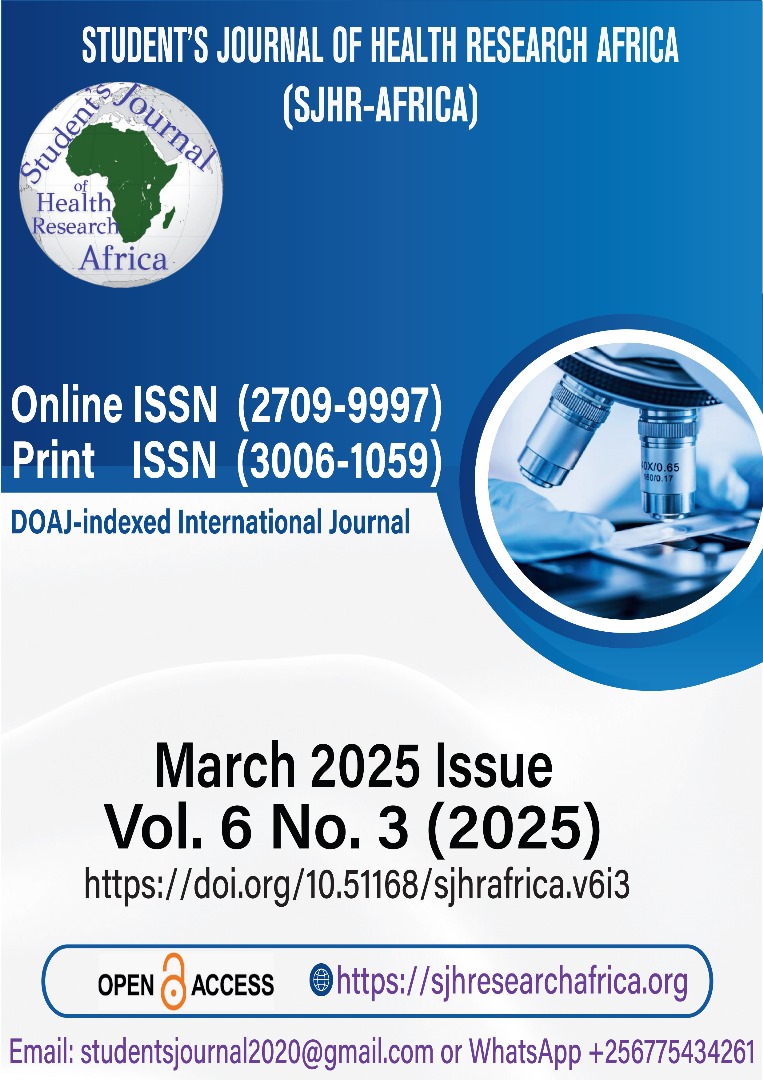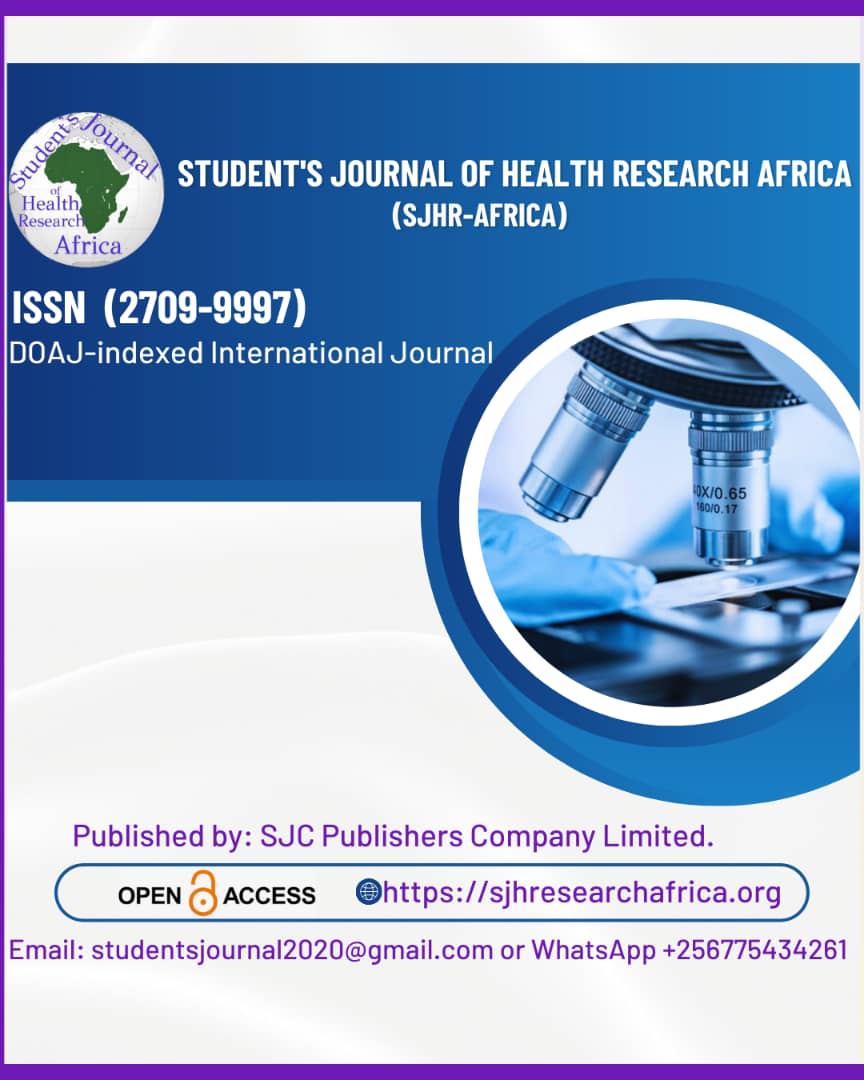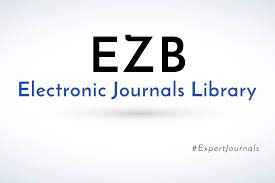CORRELATION OF AMNIOTIC FLUID INDEX VALUES WITH MATERNAL AND PERINATAL OUTCOMES IN PRETERM PREMATURE RUPTURE OF MEMBRANES.
DOI:
https://doi.org/10.51168/sjhrafrica.v6i3.1681Keywords:
Preterm Premature Rupture of Membranes, Amniotic Fluid Index, Chorioamnionitis, Neonatal Sepsis, Respiratory Distress Syndrome, Neonatal Death, Gestational Age, ObstetricsAbstract
Background:
Preterm Premature Rupture of Membranes (PPROM) is a significant obstetric complication associated with adverse neonatal outcomes. This study aims to evaluate the relationship between Amniotic Fluid Index (AFI) levels and clinical outcomes in patients with PPROM between 26–36 weeks of gestation.
Methods:
A cohort of 100 patients diagnosed with PPROM between 26–36 weeks of gestation were analyzed. Demographic data, gestational age, AFI levels, and clinical outcomes including chorioamnionitis, neonatal sepsis, respiratory distress syndrome (RDS), and neonatal survival were recorded. Statistical analysis was conducted to assess the associations between AFI levels and these clinical outcomes.
Results:
The study population consisted of 80% patients with gestational ages between 32–36 weeks and 20% between 26–31 weeks. The majority (49%) had an AFI <5. Chorioamnionitis was present in 50%, and neonatal sepsis occurred in 68% of neonates. Neonatal survival was observed in 93% of cases. Gestational age was inversely correlated with AFI (P < 0.001), with lower gestational age associated with AFI <5. No significant association was found between AFI and chorioamnionitis or neonatal sepsis. AFI <5 was significantly associated with an increased risk of RDS (P = 0.003) and neonatal death (P = 0.005), with an odds ratio of 3.78 for RDS in patients with AFI <5. Chorioamnionitis was associated with neonatal sepsis (P = 0.005).
Conclusion:
Low AFI (<5) in patients with PPROM is significantly associated with adverse neonatal outcomes, including respiratory distress syndrome and neonatal death. Gestational age and AFI levels play crucial roles in predicting neonatal survival and complications. Monitoring AFI can help identify high-risk pregnancies requiring closer observation and management.
Recommendations:
Healthcare providers should monitor AFI regularly in PPROM cases, especially with low AFI (<5). Enhanced neonatal surveillance for RDS and other complications is crucial. Early interventions and NICU preparation, particularly for gestational age <32 weeks,
References
Pylypjuk C, Majeau L. Perinatal Outcomes and Influence of Amniotic Fluid Volume Following Previable, Preterm Prelabor Rupture of Membranes (pPPROM): A Historical Cohort Study. Int J Womens Health. 2021 Jun 28;13:627-637. doi: 10.2147/IJWH.S303120. PMID: 34234574; PMCID: PMC8254139.
Wahabi H, Elmorshedy H, Bakhsh H, Ahmed S, AlSubki RE, Aburasyin AS, et al. Predictors and outcomes of premature rupture of membranes among pregnant women admitted to a teaching Hospital in Saudi Arabia: a cohort study. BMC Pregnancy Childbirth. 2024 Dec 23;24(1):850. doi: 10.1186/s12884-024-07020-x. PMID: 39716141; PMCID: PMC11667829.
Bhagat M, Chawla I. Correlation of amniotic fluid index with perinatal outcome. J Obstet Gynaecol India. 2014 Feb;64(1):32-5. doi: 10.1007/s13224-013-0467-2. Epub 2013 Oct 20. PMID: 24587604; PMCID: PMC3931909.
Vyas A, Prasanna G, Dash S, Rath S. Comparison of Perinatal and Maternal Outcomes in Borderline Versus Normal Amniotic Fluid Index in a Tertiary Care Center in Odisha: An Observational Prospective Study. Cureus. 2021 Nov 24;13(11):e19876. doi: 10.7759/cureus.19876. PMID: 34963870; PMCID: PMC8709811.
Lee YJ, Kim SC, Joo JK, Lee DH, Kim KH, Lee KS. Amniotic fluid index, single deepest pocket and transvaginal cervical length: Parameter of predictive delivery latency in preterm premature rupture of membranes. Taiwan J Obstet Gynecol. 2018 Jun;57(3):374-378. doi: 10.1016/j.tjog.2018.04.008. PMID: 29880168.
Piazze J, Anceschi MM, Cerekja A, Brunelli R, Meloni P, Marzano S, et al. Validity of amniotic fluid index in preterm rupture of membranes. J Perinat Med. 2007;35(5):394-8. doi: 10.1515/JPM.2007.077. PMID: 17624934.
Storness-Bliss C, Metcalfe A, Simrose R, Wilson RD, Cooper SL. Correlation of residual amniotic fluid and perinatal outcomes in periviable preterm premature rupture of membranes. J Obstet Gynaecol Can. 2012 Feb;34(2):154-158. doi: 10.1016/S1701-2163(16)35158-1. PMID: 22340064.
Tavassoli F, Ghasemi M, Mohamadzade A, Sharifian J. Survey of pregnancy outcome in preterm premature rupture of membranes with amniotic fluid index <5 and ≥5. Oman Med J. 2010 Apr;25(2):118-23. doi: 10.5001/omj.2010.32. PMID: 22125713; PMCID: PMC3215489.
Dayal S, Jenkins SM, Hong PL. Preterm and Term Prelabor Rupture of Membranes (PPROM and PROM) [Updated 2024 Oct 31]. In: StatPearls [Internet]. Treasure Island (FL): StatPearls Publishing; 2025 Jan-. Available from: https://www.ncbi.nlm.nih.gov/books/NBK532888/
Gunay T, Erdem G, Bilir RA, Hocaoglu M, Ozdamar O, Turgut A. The association of the amniotic fluid index (AFI) with perinatal fetal and maternal outcomes in pregnancies complicated by preterm premature rupture of membranes (PPROM). Ginekol Pol. 2020;91(8):465-472. doi: 10.5603/GP.2020.0069. PMID: 32902844.
Borna S, Borna H, Khazardoost S, Hantoushzadeh S. Perinatal outcome in preterm premature rupture of membranes with Amniotic fluid index < 5 (AFI < 5). BMC Pregnancy Childbirth. 2004 Aug 4;4(1):15. doi: 10.1186/1471-2393-4-15. PMID: 15291965; PMCID: PMC512289.
Endale T, Fentahun N, Gemada D, Hussen MA. Maternal and fetal outcomes in term premature rupture of membrane. World J Emerg Med. 2016;7(2):147-52. doi: 10.5847/wjem.j.1920-8642.2016.02.011. PMID: 27313811; PMCID: PMC4905872.
Mehra S, Amon E, Hopkins S, Gavard JA, Shyken J. Transvaginal cervical length and amniotic fluid index: can it predict delivery latency following preterm premature rupture of membranes? Am J Obstet Gynecol. 2015;212(3):400.e1-400.e9.
Kacerovsky M, Musilova I, Andrys C, Drahosova M, Hornychova H, Rezac A, et al. Oligohydramnios in women with preterm prelabor rupture of membranes and adverse pregnancy and neonatal outcomes. PLoS One. 2014 Aug 29;9(8):e105882. doi: 10.1371/journal.pone.0105882. PMID: 25171293; PMCID: PMC4149497
Downloads
Published
How to Cite
Issue
Section
License
Copyright (c) 2025 Vamsi Priya, Varada Hasamnis, Munukutla Vaidehi

This work is licensed under a Creative Commons Attribution-NonCommercial-NoDerivatives 4.0 International License.






















